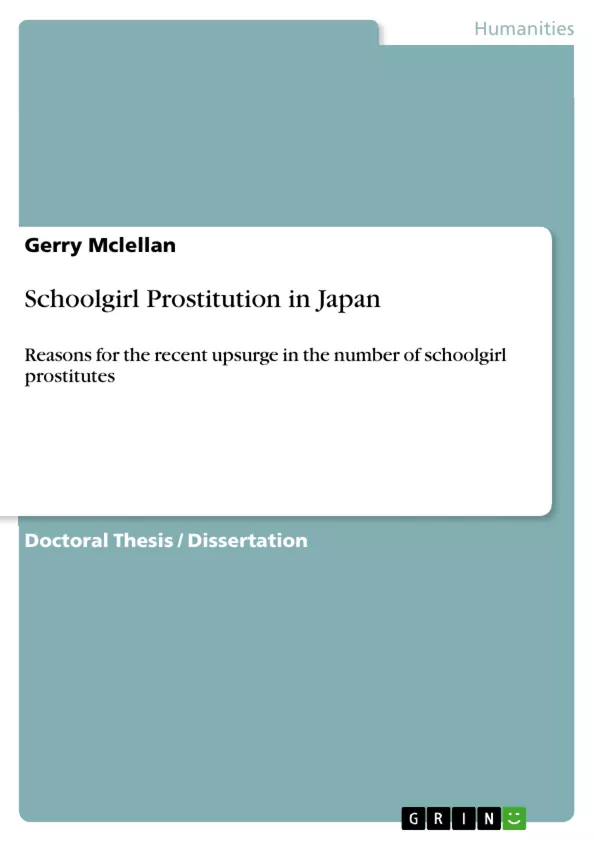
Schoolgirl Prostitution in Japan
Doktorarbeit / Dissertation, 2005
112 Seiten
Leseprobe
Table of Contents
- Introduction
- Chapter 1: What Is Enjo-kōsai?
- Enjo-kōsai as a Social/Moral Issue
- Enjo-kōsai as a Health Issue
- Chapter 2
- Chapter 3: Effects of Pornography
- Adults
- Children
- Chapter 4
- Chapter 5: Women's Role in Japanese Society
- The Role of the Internet and Mobile Telephones
- The Mass Media
Objectives and Key Themes
This dissertation aims to examine the phenomenon of enjo-kōsai in Japan, exploring its nature, causes, and consequences. It seeks to understand why this form of compensated dating involving underage girls warrants public concern, particularly in a first-world country like Japan. The study investigates the issue from both social/moral and health perspectives, considering the role of various factors in its prevalence.
- Definition and Translation of Enjo-kōsai
- Social and Health Impacts of Enjo-kōsai
- Influence of Pornography and Media Portrayals
- Historical Context of Women's Roles in Japanese Society
- The Role of Technology in Facilitating Enjo-kōsai
Chapter Summaries
Chapter 1: What Is Enjo-kōsai?: This chapter delves into the definition and various translations of "enjo-kōsai," exploring the nuances of its meaning in English. It examines the issue from both a social/moral and health perspective, addressing the ethical concerns and public health implications of sexual encounters between adult men and underage girls. The chapter also reviews existing data on the prevalence of enjo-kōsai and analyzes policy responses to this complex problem. The debate about whether it's primarily a social/moral issue or a health problem is explored, presenting arguments from various stakeholders and highlighting the challenges in accurately quantifying its extent due to the clandestine nature of the practice.
Chapter 3: Effects of Pornography: This chapter analyzes the impact of pornography on both adults and children, exploring potential links to addiction, escalation of sexual behaviors, desensitization, and acting out sexually. It examines how the portrayal of teenage girls in pornography may contribute to the normalization and even encouragement of sexual encounters with minors. The chapter highlights the potential correlation between the increased presence of young women in pornographic materials and the rise of enjo-kōsai, arguing that media representations play a significant role in shaping societal attitudes towards sex and potentially normalizing exploitative behavior.
Chapter 5: Women's Role in Japanese Society: This chapter investigates the role of women in Japanese society, exploring whether historical treatment of women correlates with the portrayal of girls in enjo-kōsai today. It examines the influence of internet and mobile technologies in facilitating the practice, as well as the role of mass media in shaping perceptions and attitudes. The discussion aims to contextualize the issue of enjo-kōsai within a broader socio-cultural framework, linking historical gender dynamics to contemporary social problems.
Keywords
Enjo-kōsai, compensated dating, teenage prostitution, child sexual exploitation, pornography, media influence, women's role in Japanese society, public health, social morality, internet, mobile phones, Japan.
Frequently Asked Questions: A Comprehensive Language Preview on Enjo-kōsai
What is the main topic of this document?
This document provides a comprehensive overview of Enjo-kōsai in Japan. It explores the phenomenon's definition, causes, consequences, and its implications from social, moral, and health perspectives. The document includes a table of contents, objectives, key themes, chapter summaries, and keywords.
What is Enjo-kōsai?
Chapter 1 delves into defining "Enjo-kōsai," exploring its nuances and examining it from social/moral and health perspectives. It addresses ethical concerns and public health implications of sexual encounters between adult men and underage girls. The chapter also reviews existing data on prevalence and analyzes policy responses.
What are the key themes explored in the document?
Key themes include defining and translating Enjo-kōsai; its social and health impacts; the influence of pornography and media portrayals; the historical context of women's roles in Japanese society; and the role of technology in facilitating Enjo-kōsai.
What is the role of pornography discussed in the document?
Chapter 3 analyzes pornography's impact on adults and children, exploring potential links to addiction, escalated sexual behaviors, desensitization, and acting out sexually. It examines how the portrayal of teenage girls in pornography might normalize or encourage sexual encounters with minors and its potential correlation with the rise of Enjo-kōsai.
What is the significance of women's roles in Japanese society in this context?
Chapter 5 investigates the role of women in Japanese society, exploring potential correlations between historical treatment of women and the portrayal of girls in Enjo-kōsai today. It examines the internet and mobile technologies' influence in facilitating the practice and the mass media's role in shaping perceptions and attitudes. The chapter aims to contextualize Enjo-kōsai within a broader socio-cultural framework.
What are the chapter summaries included in this preview?
The preview includes summaries for Chapters 1, 3, and 5. Chapter 1 defines Enjo-kōsai and explores its social/moral and health implications. Chapter 3 analyzes the effects of pornography on adults and children. Chapter 5 investigates the role of women in Japanese society and its connection to Enjo-kōsai.
What are the keywords associated with this topic?
Keywords include Enjo-kōsai, compensated dating, teenage prostitution, child sexual exploitation, pornography, media influence, women's role in Japanese society, public health, social morality, internet, mobile phones, and Japan.
What is the overall objective of this dissertation?
The dissertation aims to examine the phenomenon of Enjo-kōsai in Japan, exploring its nature, causes, and consequences. It seeks to understand why this form of compensated dating involving underage girls warrants public concern, particularly in a first-world country like Japan.
Details
- Titel
- Schoolgirl Prostitution in Japan
- Untertitel
- Reasons for the recent upsurge in the number of schoolgirl prostitutes
- Hochschule
- University of Sheffield
- Veranstaltung
- japanese Language and Society
- Autor
- Gerry Mclellan (Autor:in)
- Erscheinungsjahr
- 2005
- Seiten
- 112
- Katalognummer
- V175398
- ISBN (eBook)
- 9783640963157
- ISBN (Buch)
- 9783640963386
- Dateigröße
- 748 KB
- Sprache
- Englisch
- Schlagworte
- schoolgirl prostitution japan reasons
- Produktsicherheit
- GRIN Publishing GmbH
- Preis (Ebook)
- US$ 40,99
- Preis (Book)
- US$ 52,99
- Arbeit zitieren
- Gerry Mclellan (Autor:in), 2005, Schoolgirl Prostitution in Japan, München, Page::Imprint:: GRINVerlagOHG, https://www.diplomarbeiten24.de/document/175398
- Autor werden
- Ihre Optionen
- Vertriebskanäle
- Premium Services
- Autorenprofil
- Textarten und Formate
- Services für Verlage, Hochschulen, Unternehmen

- © GRIN Publishing GmbH.
- Alle Inhalte urheberrechtlich geschützt. Kopieren und verbreiten untersagt.
- info@grin.com
- AGB
- Open Publishing
Der GRIN Verlag hat sich seit 1998 auf die Veröffentlichung akademischer eBooks und Bücher spezialisiert. Der GRIN Verlag steht damit als erstes Unternehmen für User Generated Quality Content. Die Verlagsseiten GRIN.com, Hausarbeiten.de und Diplomarbeiten24 bieten für Hochschullehrer, Absolventen und Studenten die ideale Plattform, wissenschaftliche Texte wie Hausarbeiten, Referate, Bachelorarbeiten, Masterarbeiten, Diplomarbeiten, Dissertationen und wissenschaftliche Aufsätze einem breiten Publikum zu präsentieren.
Kostenfreie Veröffentlichung: Hausarbeit, Bachelorarbeit, Diplomarbeit, Dissertation, Masterarbeit, Interpretation oder Referat jetzt veröffentlichen!
- GRIN Verlag GmbH
-
- Nymphenburger Str. 86
- 80636
- Munich, Deutschland
- +49 89-550559-0
- +49 89-550559-10
- info@grin.com
-









